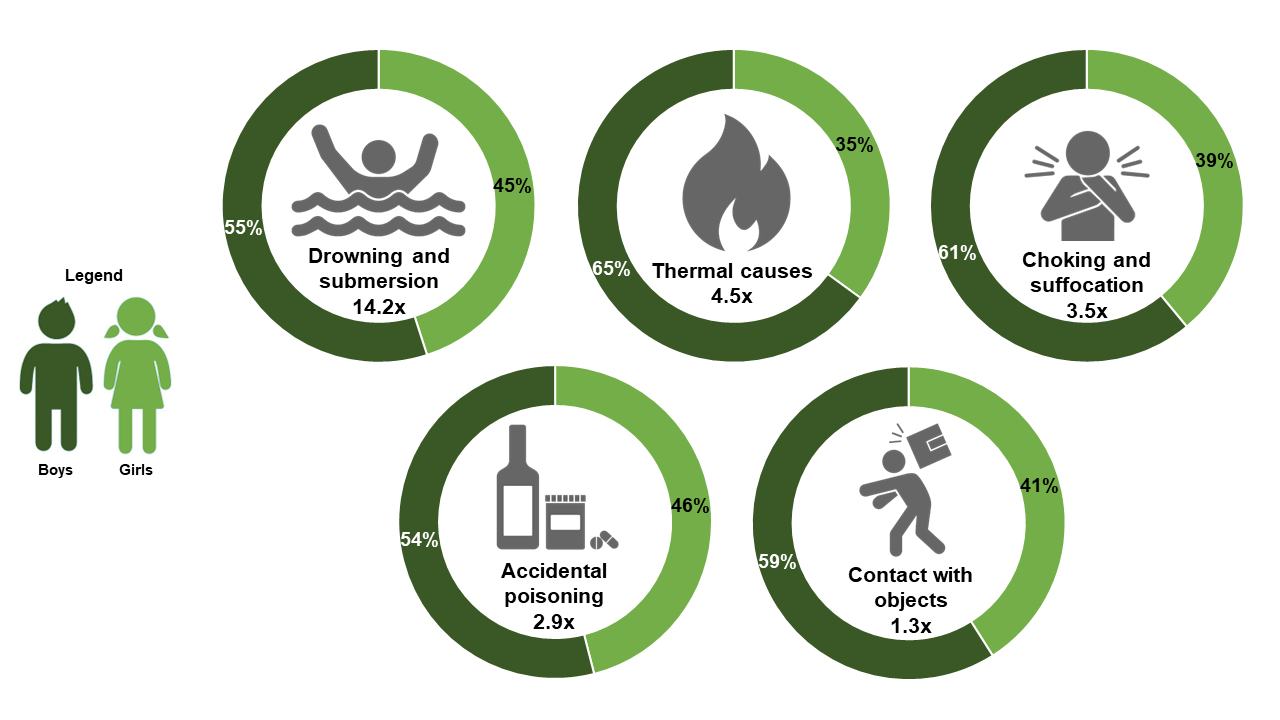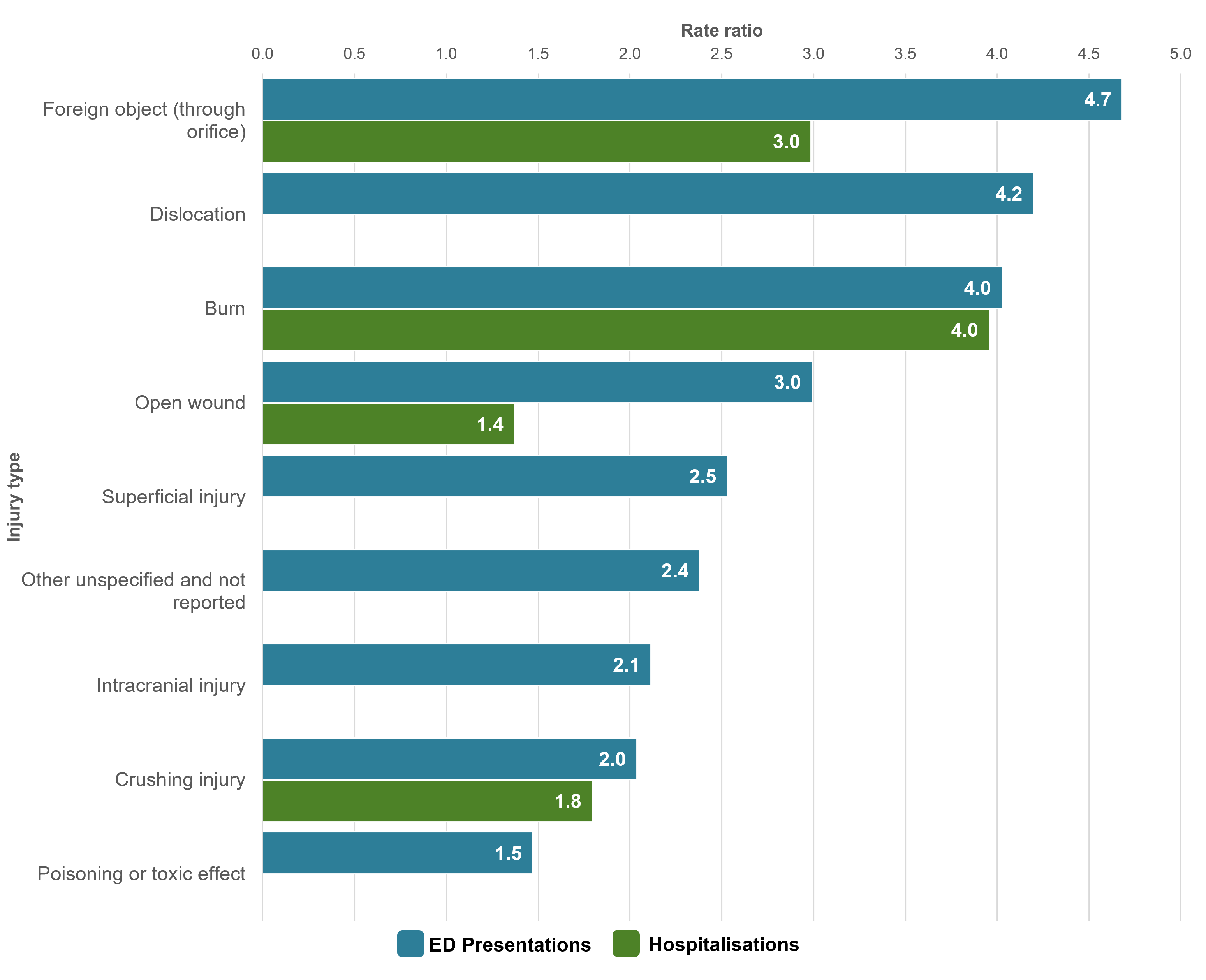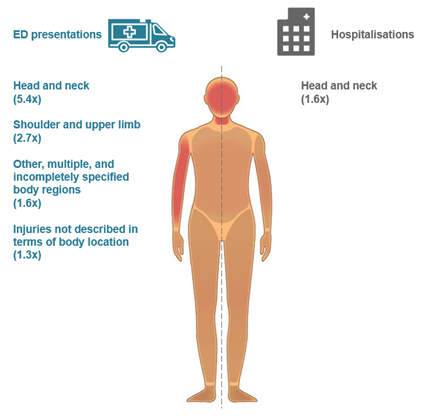Early childhood (1–4)
Toddlers and preschoolers aged 1–4 make up the early childhood developmental stage. As children progress beyond the infant stage, they begin to grow more independent and mobile, encountering new risks and mechanisms of injury. An increase in curiosity, and interest in their surroundings mean this age group is particularly prone to accidental injury and poisoning.
Causes
Children aged 1–4 are more likely than adults to be hospitalised for injuries caused by drowning and submersion, thermal causes, choking and suffocation, accidental poisoning, and contact with objects. For each of these causes, boys make up the majority of cases (Figure 23).
Figure 23: Injury hospitalisation rate ratios of children aged 1–4 compared to adults, and sex demographic proportions, by selected external cause, Australia, 2021–22

Toddlers and preschoolers are most likely to drown or have a near-drowning experience in a swimming pool (Royal Life Saving Australia 2023).
Children aged 1–4 had the highest rate of injury hospitalisation caused by drowning and submersion amongst children. They were 14.2 times more likely than adults to be hospitalised (15 and 1.0 per 100,000 respectively). For girls, this increases to 23 times (14 and 0.6 per 100,000 respectively). Nearly 3 in 5 of these injury cases occurred in a swimming pool (59%).
Younger children were most at risk of injuries due to thermal causes, which include burns and scalds caused by food and drink, contact with hot household appliances, and exposure to smoke, fire and flames (AIHW 2023g). Many injuries from thermal causes occur in the home, particularly in the kitchen (The Royal Children’s Hospital Melbourne 2021). Burn and scald injuries in young children can be more severe than adults due to their delicate skin (The Sydney Children’s Hospitals Network 2024).
Toddlers and preschoolers rapidly gain mobility and independence in this stage of development. Through exploring their environment, they are likely to touch or knock over objects containing hot substances (Better Health Channel 2019).
Children aged 1–4 had the highest rate of injury hospitalisation due to thermal causes amongst children. They were 4.5 times more likely than adults to be hospitalised (81 and 18 per 100,000 respectively). The resulting type of injury from thermal causes for this age group was almost always a burn (968, 99%). Contact with hot drinks, food, fats and cooking oils was the most common thermal cause (32%), followed by other hot fluids (16%).
Infants and young children are most at risk of injury due to choking and suffocation. Common choking hazards include food, coins and button batteries, and small toys or parts of toys. Factors that may increase risk in this population include:
- a tendency for children this age to explore their environment using their mouth (The Royal Children’s Hospital Melbourne 2018a)
- smaller airways which may get blocked easier (Denny et al. 2014)
- undeveloped teeth which hinders proper chewing (Better Health Channel 2014).
Children aged 1–4 were 3.5 times more likely than adults to be hospitalised for an injury caused by choking and suffocation (18 and 5.0 per 100,000 respectively). Inhaled food was the most common threat to breathing that obstructed the respiratory tract (43%) followed by a foreign body in the respiratory tract (28%).
Toddlers and preschoolers have a natural curiosity and desire to learn about the world around them. However, they often have not developed hazard perception skills, and so are vulnerable to accidental poisoning through ingestion of unattended or improperly stored cleaning products, medicines, cosmetics, and other harmful substances (Better Health Channel 2023; Grabska & Pilarska 2022).
Children aged 1–4 had the highest rate of injury hospitalisation due to accidental poisoning. They were 2.9 times more likely than adults to be hospitalised (98 and 34 per 100,000 respectively). This age group was most commonly poisoned by other and unspecified drugs, medicaments and biological substances (33%), which can include a wide range of substances such as vitamin tablets, cough syrups, hair dye and antibiotics.
Many objects and pieces of furniture present an injury risk to young children. Injuries caused by contact with objects (known as Exposure to inanimate mechanical forces in ICD10 coding) can include being hit by a falling tree branch, having fingers caught in a door, or crushing from furniture tip-over. Toddlers and preschoolers often explore their environment through climbing. More than half of all injuries from furniture tip-over are for children aged less than 4 (The Royal Children's Hospital Melbourne 2018b).
Children aged 1–4 had the highest rate of injury hospitalisation due to contact with objects. They were 1.3 times more likely than adults to be hospitalised (403 and 314 per 100,000 respectively). For girls compared to women, this increases to 2.2 times (337 and 156 per 100,000 respectively). Around one-quarter of injuries caused by contact with objects for this age group was due to being caught, crushed, jammed or pinched in or between objects (24%), or by striking against or struck by other objects (23%).
Nature of injuries sustained
Children aged 1–4 experience higher rates of injury ED presentations than adults for the majority of injury types. This age group is at higher risk of injuries involving a foreign object (through orifice) than adults, and was 4.7 times more likely to have an ED presentation, and 3.0 times more likely to have an injury hospitalisation (Figure 24). Over a quarter of these hospitalisations was for a foreign body in the ear (27%).
Figure 24: Selected rate ratios of injury emergency department presentations and hospitalisations among children aged 1–4, by type of injury, 2021–22

Some types of injury are more prevalent in children compared to adults only in one sex. When comparing girls aged 1–4 with women, girls were:
- 2.5 times more likely than women to have an ED presentation for amputation
- 3.0 times more likely than women to be hospitalised for amputation.
Head and neck injuries made up 53% of all injury ED presentations for 1–4 year-olds, and 50% of injury hospitalisations. The sites of injury that children aged 1–4 are more likely than adults to have an ED presentation or hospitalisation are shown in Figure 25.
Figure 25: Selected rate ratios for emergency department presentations and hospitalisations among children aged 1–4, by site of injury, Australia, 2021–22

AIHW (2023g) Thermal causes, AIHW, Australian Government, accessed 22 February 2024.
Better Health Channel (2014) Choking, Department of Health, State Government of Victoria, accessed 21 February 2024.
Better Health Channel (2019) Burns and scalds – children, Department of Health, State Government of Victoria, accessed 22 February 2024.
Better Health Channel (2023) Poisoning and child safety, Department of Health, State Government of Victoria, accessed 22 February 2024.
Denny S, Hodges N & Smith G (2014) Choking in the Pediatric Population, American Journal of Lifestyle Medicine, 9(6), doi: 10.1177/1559827614554901.
Grabska K & Pilarska I (2022) Acute poisoning among children and adolescents: a narrative review, Medical Science Pulse, 16(3), doi: 10.5604/01.3001.0015.9656
Royal Life Saving Australia (2023) National Drowning Report, Royal Life Saving Australia, accessed 21 February 2024.
The Royal Children's Hospital Melbourne (2018a) Safety: Choking, suffocation and strangulation prevention, The Royal Children's Hospital Melbourne, accessed 21 February 2024.
The Royal Children's Hospital Melbourne (2018b) Safety: Furniture tip-over prevention, The Royal Children’s Hospital Melbourne, accessed 22 February 2024.
The Royal Children's Hospital Melbourne (2021) Burns – prevention and first aid, The Royal Children’s Hospital Melbourne, accessed 22 February 2024.
The Sydney Children's Hospitals Network (2024) Burn injuries, NSW Government, accessed 22 February 2024.


